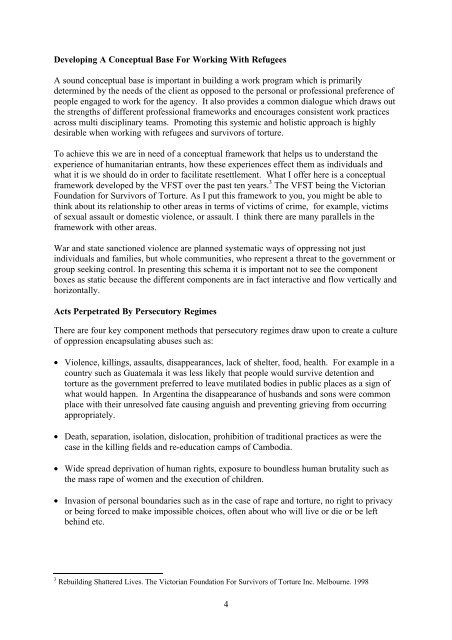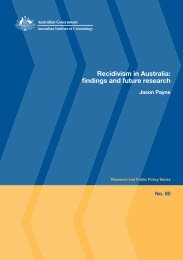Developing cultural responsiveness in the delivery of services to ...
Developing cultural responsiveness in the delivery of services to ...
Developing cultural responsiveness in the delivery of services to ...
You also want an ePaper? Increase the reach of your titles
YUMPU automatically turns print PDFs into web optimized ePapers that Google loves.
<strong>Develop<strong>in</strong>g</strong> A Conceptual Base For Work<strong>in</strong>g With Refugees<br />
A sound conceptual base is important <strong>in</strong> build<strong>in</strong>g a work program which is primarily<br />
determ<strong>in</strong>ed by <strong>the</strong> needs <strong>of</strong> <strong>the</strong> client as opposed <strong>to</strong> <strong>the</strong> personal or pr<strong>of</strong>essional preference <strong>of</strong><br />
people engaged <strong>to</strong> work for <strong>the</strong> agency. It also provides a common dialogue which draws out<br />
<strong>the</strong> strengths <strong>of</strong> different pr<strong>of</strong>essional frameworks and encourages consistent work practices<br />
across multi discipl<strong>in</strong>ary teams. Promot<strong>in</strong>g this systemic and holistic approach is highly<br />
desirable when work<strong>in</strong>g with refugees and survivors <strong>of</strong> <strong>to</strong>rture.<br />
To achieve this we are <strong>in</strong> need <strong>of</strong> a conceptual framework that helps us <strong>to</strong> understand <strong>the</strong><br />
experience <strong>of</strong> humanitarian entrants, how <strong>the</strong>se experiences effect <strong>the</strong>m as <strong>in</strong>dividuals and<br />
what it is we should do <strong>in</strong> order <strong>to</strong> facilitate resettlement. What I <strong>of</strong>fer here is a conceptual<br />
framework developed by <strong>the</strong> VFST over <strong>the</strong> past ten years. 3 The VFST be<strong>in</strong>g <strong>the</strong> Vic<strong>to</strong>rian<br />
Foundation for Survivors <strong>of</strong> Torture. As I put this framework <strong>to</strong> you, you might be able <strong>to</strong><br />
th<strong>in</strong>k about its relationship <strong>to</strong> o<strong>the</strong>r areas <strong>in</strong> terms <strong>of</strong> victims <strong>of</strong> crime, for example, victims<br />
<strong>of</strong> sexual assault or domestic violence, or assault. I th<strong>in</strong>k <strong>the</strong>re are many parallels <strong>in</strong> <strong>the</strong><br />
framework with o<strong>the</strong>r areas.<br />
War and state sanctioned violence are planned systematic ways <strong>of</strong> oppress<strong>in</strong>g not just<br />
<strong>in</strong>dividuals and families, but whole communities, who represent a threat <strong>to</strong> <strong>the</strong> government or<br />
group seek<strong>in</strong>g control. In present<strong>in</strong>g this schema it is important not <strong>to</strong> see <strong>the</strong> component<br />
boxes as static because <strong>the</strong> different components are <strong>in</strong> fact <strong>in</strong>teractive and flow vertically and<br />
horizontally.<br />
Acts Perpetrated By Persecu<strong>to</strong>ry Regimes<br />
There are four key component methods that persecu<strong>to</strong>ry regimes draw upon <strong>to</strong> create a culture<br />
<strong>of</strong> oppression encapsulat<strong>in</strong>g abuses such as:<br />
• Violence, kill<strong>in</strong>gs, assaults, disappearances, lack <strong>of</strong> shelter, food, health. For example <strong>in</strong> a<br />
country such as Guatemala it was less likely that people would survive detention and<br />
<strong>to</strong>rture as <strong>the</strong> government preferred <strong>to</strong> leave mutilated bodies <strong>in</strong> public places as a sign <strong>of</strong><br />
what would happen. In Argent<strong>in</strong>a <strong>the</strong> disappearance <strong>of</strong> husbands and sons were common<br />
place with <strong>the</strong>ir unresolved fate caus<strong>in</strong>g anguish and prevent<strong>in</strong>g griev<strong>in</strong>g from occurr<strong>in</strong>g<br />
appropriately.<br />
• Death, separation, isolation, dislocation, prohibition <strong>of</strong> traditional practices as were <strong>the</strong><br />
case <strong>in</strong> <strong>the</strong> kill<strong>in</strong>g fields and re-education camps <strong>of</strong> Cambodia.<br />
• Wide spread deprivation <strong>of</strong> human rights, exposure <strong>to</strong> boundless human brutality such as<br />
<strong>the</strong> mass rape <strong>of</strong> women and <strong>the</strong> execution <strong>of</strong> children.<br />
• Invasion <strong>of</strong> personal boundaries such as <strong>in</strong> <strong>the</strong> case <strong>of</strong> rape and <strong>to</strong>rture, no right <strong>to</strong> privacy<br />
or be<strong>in</strong>g forced <strong>to</strong> make impossible choices, <strong>of</strong>ten about who will live or die or be left<br />
beh<strong>in</strong>d etc.<br />
3 Rebuild<strong>in</strong>g Shattered Lives. The Vic<strong>to</strong>rian Foundation For Survivors <strong>of</strong> Torture Inc. Melbourne. 1998<br />
4















